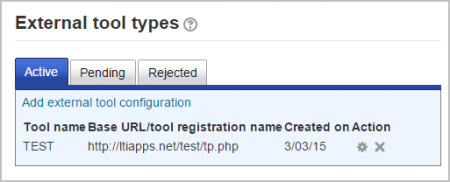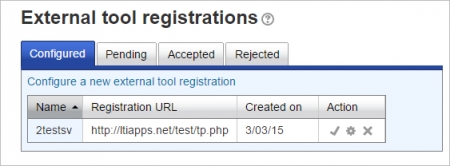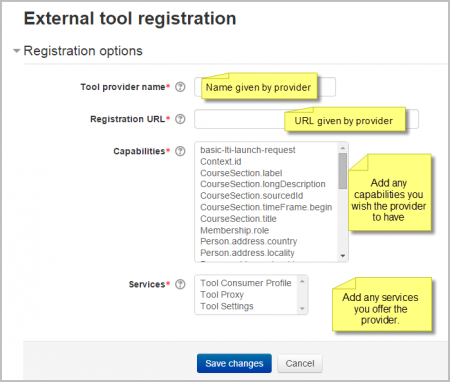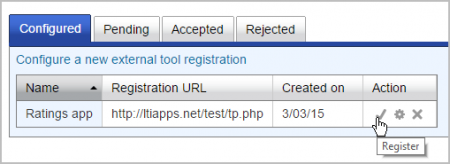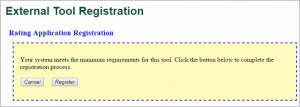Diferencia entre revisiones de «28/Configuraciones de herramienta externa»
({{Pendiente de traducir}}) |
(updated as per 3.0 Docs) |
||
| Línea 1: | Línea 1: | ||
{{Pendiente de traducir}} | |||
{{Herramienta externa}} | {{Herramienta externa}} | ||
A teacher can add an external tool from their course page and an administrator can make an external tool available to all teachers on the site. | A teacher can add an external tool from their course page and an administrator can make an external tool available to all teachers on the site. | ||
== | ==Adding a new external tool to a course== | ||
#With the editing turned on,in the section you wish to add your external tool, click the "Add an activity or resource" link (or, if not present, the "Add an activity" drop down menu )and choose ''External tool'' | #With the editing turned on,in the section you wish to add your external tool, click the "Add an activity or resource" link (or, if not present, the "Add an activity" drop down menu )and choose ''External tool'' | ||
#This will take you to the settings page titled "Adding a new external tool". All settings may expanded by clicking the "Expand all" link top right. | #This will take you to the settings page titled "Adding a new external tool". All settings may expanded by clicking the "Expand all" link top right. | ||
#If the external tool has not been configured by the administrator, you will need to have in advance the correct URL, consumer key and secret. These should have been provided to you by the managers of the LTI compliant website you are going to be connecting to. Click "Show more" to access the consumer key and secret fields. | #If the external tool has not been configured by the administrator, you will need to have in advance the correct URL, consumer key and secret. These should have been provided to you by the managers of the LTI compliant website you are going to be connecting to. Click "Show more" to access the consumer key and secret fields. | ||
== | ==General settings== | ||
{| | {| | ||
|[[File:externaltool26.png|thumb|400px|General settings before expanding. When expanded, [https://docs.moodle.org/en/File:externaltoolexpanded.png extra options are available.]]] | |[[File:externaltool26.png|thumb|400px|General settings before expanding. When expanded, [https://docs.moodle.org/en/File:externaltoolexpanded.png extra options are available.]]] | ||
|} | |} | ||
*'''Activity name''' - give the title you wish the students to see on the course page | *'''Activity name''' - give the title you wish the students to see on the course page | ||
*'''External tool type''' -this is how Moodle communicates with the tool provider. If in doubt, leave as default. If your administrator has made a tool available sitewide, you will be able to select it here: | *'''External tool type''' -this is how Moodle communicates with the tool provider. If in doubt, leave as default. If your administrator has made a tool available sitewide, you will be able to select it here: | ||
| Línea 40: | Línea 40: | ||
*'''Secure Icon URL''' - enter the URL of a different icon here if your students are accessing Moodle securely via SSL. | *'''Secure Icon URL''' - enter the URL of a different icon here if your students are accessing Moodle securely via SSL. | ||
== | ==Privacy settings== | ||
(These settings are collapsed by default) | (These settings are collapsed by default) | ||
{| | {| | ||
| Línea 46: | Línea 46: | ||
|} | |} | ||
*'''Share launcher's name with the tool''' - this means that the student's name will be displayed on the connected site [ | *'''Share launcher's name with the tool''' - this means that the student's name will be displayed on the connected site [[ Media:demoexternaltool.png| as in this example]] | ||
*'''Share launcher's email with the tool''' - this means that the student's email will be displayed on the connected site [ | *'''Share launcher's email with the tool''' - this means that the student's email will be displayed on the connected site [[Media:externaltoolfrontpage.png| as in this example]] | ||
*'''Accept grades from the tool''' - if this is checked, the connecting site will send back grades to Moodle's gradebook. See [ | *'''Accept grades from the tool''' - if this is checked, the connecting site will send back grades to Moodle's gradebook. See [[Using External tool]] for more information on this. | ||
==Site administration settings== | |||
===Adding a tool site-wide=== | |||
An administrator can manually configure external tools in ''Site administration > Plugins > Activity modules > LTI > Manage external tool types'' so that they are available across the site. There are tabs to add an external tool, to view those which are pending and to view those which have been rejected: | |||
{| | |||
| [[File:LTItype.png|thumb|450px|Setting up a new external tool]] | |||
|} | |||
== | ===Registrando una herramienta externa=== | ||
== | |||
Una herramienta externa puede ser registrada por un administrador como sigue: | |||
1. Vaya a ''Administración del sitio > Plugins > Módulos de actividad > LTI > Gestionar registros de herramienta externa'' | |||
[[File:LTIreg.png|thumb|450px|center|Registrando una herramienta externa]] | |||
2. Configure los detalles en la página de configuraciones: | |||
[[File:LTIregdetails1.png|450px|center|Página para configuración del registro]] | |||
{{Nuevas características de Moodle 3.0}}Un nuevo servicio disponible a partir de Moodle 3.0 es 'Membresías' (''Memberships''), que le permiten a la herramienta externa solicitar una lista de usuarios con un cierto [[Rol|rol]] en un [[Contexto|contexto]] especificado, como por ejemplo usuarios inscritos en un curso. | |||
3. Click the tick/checkmark to register: | |||
[[File:ticktoreg.png|center|thumb|450px|Activating]] | |||
4. After obtaining a success message, click to complete the process: | |||
[[File:reqmet.png|450|thumb|center|Completing the registration]] | |||
5. If all requirements are met then you will be able to register automatically. | |||
6. Now go to ''Site administration > Plugins > Activity modules > LTI > Manage external tool types'' and click the 'Pending tab' | |||
7. Click the tick/checkmark to activate it: | |||
[[File:pendingactivate.png|thumb|center|450px|Activating from the Pending tab]] | |||
See the screencast [http://www.spvsoftwareproducts.com/temp/lti2-moodle/ External tool registration] for a demonstration of the above steps. | |||
== | ==External tool capabilities== | ||
*[[ | *[[Capabilities/mod/lti:addcoursetool|Add external tool]] | ||
*[ | *[[Capabilities/mod/lti:requesttooladd|Submit a tool to admins for configuration]] | ||
*[ | *[[Capabilities/mod/lti:grade|Grade external tool activities]] | ||
*[ | *[[Capabilities/mod/lti:manage|Edit external tool activities]] | ||
*[ | *[[Capabilities/mod/lti:view|View external tool activities]] | ||
*[ | *[[Capabilities/mod/lti:addinstance|Add a new external tool activity]] | ||
[[en:External tool settings]] | [[en:External tool settings]] | ||
Revisión del 23:32 5 mar 2016
Nota: Pendiente de Traducir. ¡Anímese a traducir esta página!. ( y otras páginas pendientes)
A teacher can add an external tool from their course page and an administrator can make an external tool available to all teachers on the site.
Adding a new external tool to a course
- With the editing turned on,in the section you wish to add your external tool, click the "Add an activity or resource" link (or, if not present, the "Add an activity" drop down menu )and choose External tool
- This will take you to the settings page titled "Adding a new external tool". All settings may expanded by clicking the "Expand all" link top right.
- If the external tool has not been configured by the administrator, you will need to have in advance the correct URL, consumer key and secret. These should have been provided to you by the managers of the LTI compliant website you are going to be connecting to. Click "Show more" to access the consumer key and secret fields.
General settings
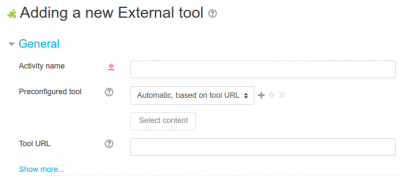 General settings before expanding. When expanded, extra options are available. |
- Activity name - give the title you wish the students to see on the course page
- External tool type -this is how Moodle communicates with the tool provider. If in doubt, leave as default. If your administrator has made a tool available sitewide, you will be able to select it here:

|
- Launch URL - This is the URL for connecting to site.
- Launch container- this is how the external tool will be displayed.
- Default -if in doubt; leave as default
- Embed - the external tool will be embedded in the Moodle course page with blocks and navigation bar
- Embed without blocks - the external tool will be embedded in the Moodle course page but without blocks
- New Window - the external tool will open in a new window. (A new window or tab will open with the External tool and the old browser window containing the course page will not change.)
The following settings are available by clicking ""Show more":
- Activity description - give a short description here
- Display description on course page - choose to show the description along with the activity name
- Display activity name when launched - have this appear when the student clicks the link.
- Display activity description when launched - have this appear when the student clicks the link.
- Secure launch URL -
- Consumer key -this tells the connecting LTI compliant site that your Moodle is allowed to connect. The "tool provider", ie the manger of the connecting LTI compliant site will issue you with this key. If you are merely linking to a tool with no secure access or gradebook sharing then you won't need a consumer key.
- Shared secret - this is the "password" to connect to the tool - the LTI compliant site.
- Custom parameters - most times you can leave this blank. The tool provider might use this to allow you to display a specific resource.
- Icon URL - you can display a different icon from the default External Tool icon by entering its URL here
- Secure Icon URL - enter the URL of a different icon here if your students are accessing Moodle securely via SSL.
Privacy settings
(These settings are collapsed by default)

|
- Share launcher's name with the tool - this means that the student's name will be displayed on the connected site as in this example
- Share launcher's email with the tool - this means that the student's email will be displayed on the connected site as in this example
- Accept grades from the tool - if this is checked, the connecting site will send back grades to Moodle's gradebook. See Using External tool for more information on this.
Site administration settings
Adding a tool site-wide
An administrator can manually configure external tools in Site administration > Plugins > Activity modules > LTI > Manage external tool types so that they are available across the site. There are tabs to add an external tool, to view those which are pending and to view those which have been rejected:
Registrando una herramienta externa
Una herramienta externa puede ser registrada por un administrador como sigue:
1. Vaya a Administración del sitio > Plugins > Módulos de actividad > LTI > Gestionar registros de herramienta externa
2. Configure los detalles en la página de configuraciones:
¡Nueva característica
en Moodle 3.0!
Un nuevo servicio disponible a partir de Moodle 3.0 es 'Membresías' (Memberships), que le permiten a la herramienta externa solicitar una lista de usuarios con un cierto rol en un contexto especificado, como por ejemplo usuarios inscritos en un curso.
3. Click the tick/checkmark to register:
4. After obtaining a success message, click to complete the process:
5. If all requirements are met then you will be able to register automatically.
6. Now go to Site administration > Plugins > Activity modules > LTI > Manage external tool types and click the 'Pending tab'
7. Click the tick/checkmark to activate it:
See the screencast External tool registration for a demonstration of the above steps.
